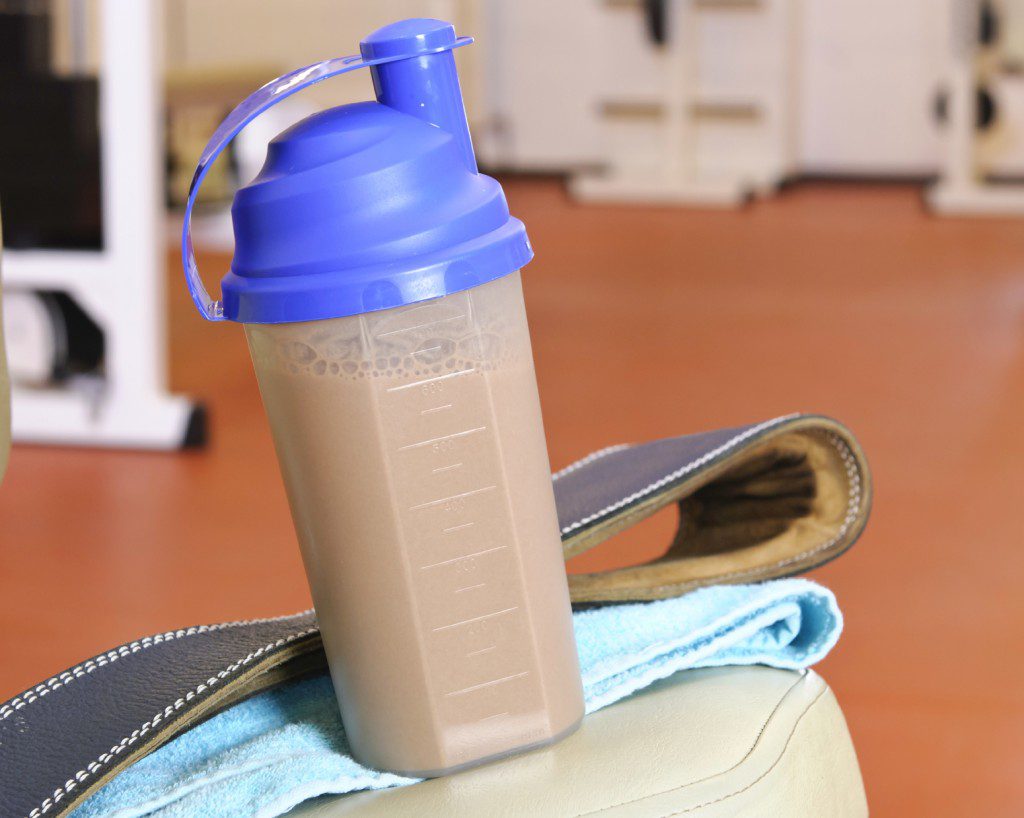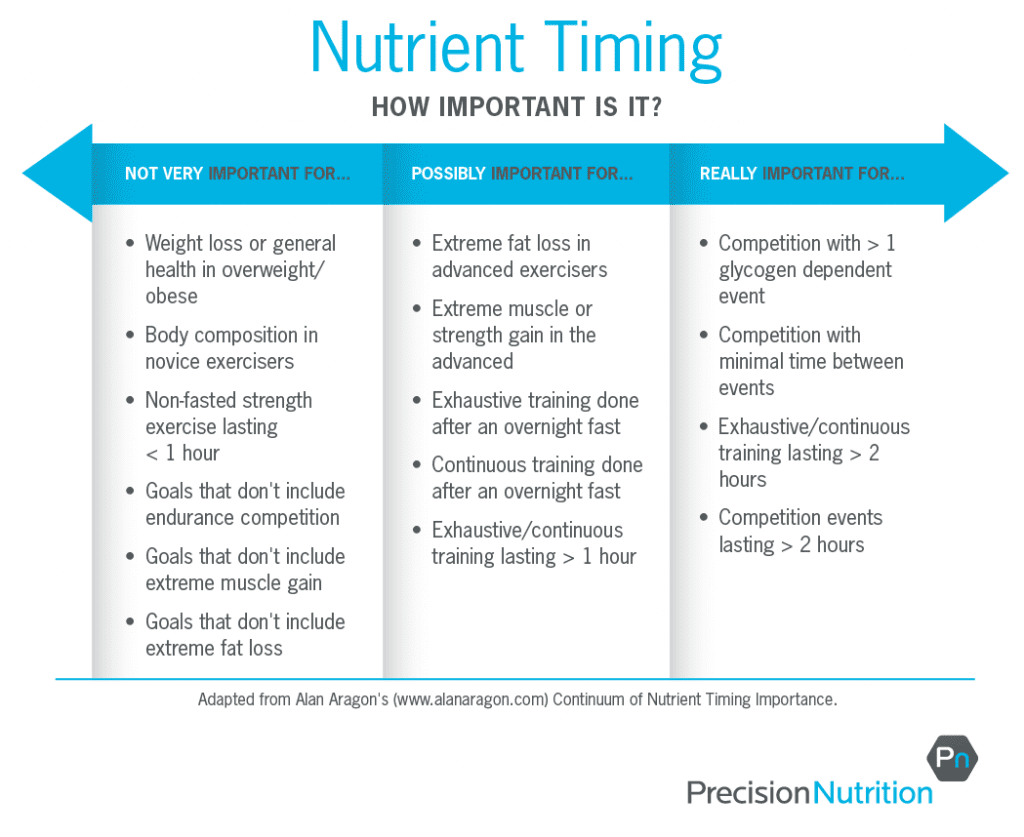“Nutrient timing” sounds impressive. Science-y. The way sport and exercise people throw it around, you’d think it must be pretty important.
But is it really? Does when you eat really matter? For health? For body composition? For performance?
Let’s take a closer look and find out.
Nutrient timing — simplified
Nutrient timing simply means eating specific nutrients (such as protein or carbs)… in specific amounts… at specific times (such as before, during, or after exercise).
Researchers have explored this practice from different angles over the last few decades. And their findings have generated a lot of excitement.
In the early 2000s, with the publication of Nutrient Timing: The Future of Sports Nutrition by Drs. John Ivy and Robert Portman, the idea of nutrient timing became the “Next Big Thing.”
Seriously, every sports nutritionist worth their branched chain amino acids owned a copy. Including yours truly. I even wrote a few college papers on the topic.
And our very own Dr. John Berardi — JB, as he’s known around here — was one of the early researchers in this area.
Much of his Masters and PhD research was done looking at nutrient timing and how it affected recovery from very intense exercise. He even contributed to the aforementioned nutrient timing book.
Postworkout and anytime meals
No surprise, the concept of nutrient timing worked its way into Precision Nutrition’s general recommendations. We divided meals into post-workout (PW) or anytime (AT), these categories implying that different meals should be eaten at different times of the day.
For example:
- PW meals are higher in carbs, especially faster-digesting starchy carbs (such as potatoes or rice) or sweeter carbs (such as fruit).
- AT meals are lower in carbs, focusing more on lean protein plus healthy fats and high-fiber vegetables.
The scientific evidence — limited at the time — seemed to show that this strategic placement of carbs could help hard-exercising people perform better while getting leaner, stronger, and healthier.
But the evidence wasn’t limited to athletes. Even type 2 diabetics respond better to carbohydrates after a carbohydrate-depleting workout. Thus, our PW/AT recommendations were born.
But things have changed
Just like JB’s choice of facial hair, and my transition from athlete to dad, things have changed in the last 10-15 years.
Well, not so much changed. Rather, our knowledge has deepened, as it always does when more research becomes available.
Since the early 2000s, for example, we’ve discovered that some of those early studies had design flaws or weaknesses.
- First, they were mostly short-term — spanning a few weeks or months, maybe even just a few workout sessions. Because of this, they didn’t really tell us what would happen over a longer time span.
- Second, they considered what we call “soft” end-points, such as protein synthesis, glycogen replenishment, or nitrogen balance. Because of this, we didn’t have data on “hard” endpoints such as actual fat loss or lean mass gain.
Interestingly, as more long-term data appeared, nutrient timing started to seem like less of a universal solution.
Sure, there were still strong indications that it could be useful and important in certain scenarios. For example, many of our clients reported fantastic results. Plus, there’s the famous and often-cited 2006 study by Cribb and Hayes.
In that study, the researchers showed that protein, carbohydrates, and creatine taken around a training session could lead to more muscle mass and strength gain than those same nutrients eaten further from the session.
Unfortunately very few people talk about the flip side: Further research, using similar protocols, failed to find the same effect.
Nutrient timing may not be all that important
So, what do we make of this?
Well, research studies aren’t perfect. And findings don’t always agree. So rather than duking it out on a study-by-study basis, I’ll bottom-line it for you.
Based on the current body of research, and PN’s experience with more than 30,000 clients, I’ve come to realize that nutrient timing isn’t particularly important for most people trying to look and feel better.
Let me be clear: no, I don’t think nutrient timing is dead, worthless, whatever. In certain situations it’s probably really important. (We’ll explore them below.)
However, lots of really smart and hard working people are getting lost in the finer points of nutrient timing, while consistently missing out on sleep, or vegetables, or other — more important — health and lifestyle factors. And that’s a shame.
So, that’s my bottom line. But, if you’re up for it, let’s go a little deeper.
Post-workout “anabolic window of opportunity”
For years, the Holy Grail of nutrient timing research has been something we call the post-workout “anabolic window of opportunity.”
The basic idea is that after exercise, especially within the first 30-45 minutes or so, our bodies are greedy for nutrients.
In theory, movement — especially intense movement, such as weight training or sprint intervals — turns our bodies into nutrient-processing powerhouses.
During this time our muscles suck in glucose hungrily, either oxidizing it as fuel or more readily storing it as glycogen (instead of fat). And post-workout protein consumption cranks up protein synthesis.
In fact, one study even showed that waiting longer than 45 minutes after exercise for a meal would significantly diminish the benefits of training.

Hurry, the anabolic window is closing!
With these physiological details in people’s minds, it became gospel that we should consume a fast-digesting protein and carbohydrate drink the minute our training ended.
Or, even better, immediately before training. (Maybe even during training, too, just for good measure.)
It seemed that the faster we could get these nutrients into our systems, the better.
Seriously, I couldn’t have been the only one who started to panic the second the last dumbbell hit the floor, ripping open my sports drink container with fumbling fingers, desperate to catch that magic protein synthesis train.
Go! Go! Go! Anabolic window is closing!
The only problem: research supporting this idea was short-term.
And just because we see positive effects in the short-term (like, in the next half-hour) doesn’t mean these effects will contribute to long-term results (like, in 3 months).
In fact, recent longer-term studies, as well as two incredibly thorough reviews, indicate that the “anabolic window of opportunity” is actually a whole lot bigger than we used to believe.
It’s not a tiny porthole that you practically have to squint to see through. It’s a huge, cathedral-like opening.
Chill out man, there’s still time
While it’s still wise to bookend your training with protein and carbohydrates, you probably have one or two hours on both sides of your training to get those benefits.
What’s more, for most people — save a few specific types of athletes — it doesn’t seem to matter how fast you digest things.
So imagine this:
Rather than worrying about slamming down some waxy maize starch and whey hydrolysate immediately after training, shoving people out of the way on your mad dash to your gym bag for your Super Shake bottle, you can actually drive home, take a shower, prepare, and eat a delicious whole food mixed meal.
To back up this idea, recent data suggests that the total amount of protein and carbohydrate you eat, over the course of the day, is more important for body composition and performance than nutrient timing strategies.
So, make no mistake, we’re not done with workout nutrition. (In fact, I’ve outlined our current workout nutrition strategies in Workout nutrition: What to eat before, during, and after exercise.) Rather, we’re simply more open to the idea that there are several ways to eat for performance and body composition.
In other words, there’s no one, immutable, do-it-this-way-or-you’re-screwed approach. When is there ever?
How about meal scheduling?
Eager gym-goers and researchers have also wondered about another nutrient-timing concept: if there’s a “best time” to eat.
For years, most nutrition experts told people to eat more of their calories and carbs at breakfast, and to keep calories — and especially carbs — lower at night.
Then, all of a sudden, some newfangled experts began recommending the opposite, telling us to eat the majority of our calories and carbohydrates at a dinner-time feast. (Nowadays this idea is associated with something called carb back-loading.)
So who’s right?
The breakfast club
The research in this area remains limited, but it is interesting.
A recent study asked: Does it matter whether you eat half your day’s calories at dinner or at breakfast? And, by “matter,” the researchers mean: would it affect body weight, waist circumference, appetite, and several blood markers of glucose tolerance and insulin sensitivity?
Well, the group who ate half of their daily calories at breakfast lost more weight and more inches from their waists, showed greater improvements in glucose control and insulin sensitivity, and reported being more satisfied (along with having lower levels of grehlin, our main hunger hormone).
Wow. Clearly eating more calories at breakfast is the way to go, right?
No, no…it’s all about dinner
Not so fast. The “carbs and calories at dinner” folks can also call on research to support their views.
Take, for example, the Journal of Nutrition study that compared eating 70 percent of your calories at night versus eating them at breakfast.
In highly controlled settings, where all subjects completed resistance and aerobic exercise, the calories-at-dinner group retained more muscle and lost an equal amount of body fat to the calories-at-breakfast group!
Not only that, but more recently, a six month study found that weight loss, waist circumference, and body fat loss were all greater when the majority of the day’s carbohydrate intake was at night, rather than spread evenly throughout the day.
The “more carbs at night” protocol was also better at improving glucose control, markers of inflammation, blood lipids, and appetite.
OK, forget the schedule
So who’s right? The breakfast advocates or the dinner advocates? Well, it depends.
Some research has found breakfast to be the best time for big meals (3 studies), some has found no differences in weight loss between big breakfasts and big dinners (2 studies), and other research has found significant benefits from eating more at night (2 studies).
What can we discern from this contradictory mish-mash of findings?
Really, it’s simple:
We’re all unique. There’s no one-size-fits all rule.
Indeed, research into circadian rhythms has found that humans (and animals) vary a lot in their natural sleep-wake cycles. So why wouldn’t the same diversity be true of our natural feed-fast cycles?
The take-home message:
Follow your evidence. Track your experience. Do what works — measurably — for you. Flow with your natural inclination, and where your own self-experimentation takes you.
If early sunshine and scrambled eggs gets you through the day feeling awesome, great. If a robust dinner is more your thing, enjoy drifting off to sleep with the warm fuzzy feeling of a full belly.
Just like when you exercise, what’s most important is you make high-quality choices, consistently, whenever it works for you.
But what about… no breakfast?
The “calories at breakfast” vs. “calories at dinner” debate also raises the question: What about skipping breakfast?
Wait a minute. No breakfast?
Surely everybody knows that breakfast is the most important meal of the day! And, in particular, that it’s a good idea to eat most of our carbs in the morning.
Well, at least that’s what my grandparents always told me.
Behind this recommendation lies the notion that by breakfast time, we’ve fasted for eight to twelve hours. Our bodies are therefore primed to use nutrients (and especially carbs) more effectively than at other times of the day.
Our glycogen levels, especially those in our livers, are running low. Plus, some evidence does suggest that we use carbohydrates more effectively in the morning than at night.
So it seems only logical to make sure we take in more carbs at breakfast than at dinner. Right?
By now I hope you see how this argument falls apart.
It’s not that having breakfast is wrong; or that having carbohydrates at breakfast is wrong. In fact, both choices are just fine.
What’s wrong is the assumption that what works for you is necessarily what’s best for everyone.
Shattering the breakfast myth

While almost everyone in nutrition, for the last 20 years, has repeated the “breakfast is the most important meal of the day” story, it turns out that this argument in favor of breakfast is actually quite weak.
The only support comes from correlational research (X and Y happen at the same time), and not causal research (Y happens because of X). And that makes the “evidence” flawed.
In a recent American Journal of Clinical Nutrition paper, researchers analyzed dozens of studies to look at the relationship between breakfast and body weight.
Their conclusion: The commonly cited link between eating breakfast and lower body weight is “only presumed true.”
Presumed true. As in “People think it’s true.” Not for-sure true. As in, “We know it’s true.”
That doesn’t sound terribly definitive, does it?
Of course, just because one study came to a certain conclusion doesn’t mean the case is closed.
So let’s take a closer look at some of the proposed benefits of eating breakfast.
The benefits of breakfast
In the literature, eating breakfast is consistently associated with:
- decreased overall appetite;
- decreased overall food consumption;
- decreased body weight;
- improved academic performance; and/or
- improved blood sugar control.
If we stopped there, of course we’d assume that skipping breakfast is a dumb move.
However, we can’t stop there. Because, again, most of this evidence is observational. It suggests there’s a relationship — a correlation — without proving a cause.
So here’s the bottom line: When examining research that actually controls for all the variables and looks at cause and effect, the results are pretty mixed.
In other words, breakfast looks to be beneficial for some of us. But not for others.
The strongest of this evidence suggests that breakfast is most important for malnourished or impoverished children. But, for other populations, it seems to be just another meal. No better. No worse. Completely negotiable.
The benefits of no breakfast
If breakfast isn’t all it’s cracked up to be, what about skipping breakfast? Because — you guessed it — some research actually suggests that skipping breakfast might make you stronger, leaner, and healthier. (By now, my grandparents must be groaning.)
For example:
- Folks with Type 2 diabetes did better when they skipped breakfast altogether and ate a larger lunch.
- Other folks who were told to skip breakfast ended up eating less overall compared to breakfast eaters.
- And skipping breakfast was found to be just as effective as eating breakfast for weight loss.
So, will skipping breakfast be better for you?
Maybe yes. Maybe no.
Preliminary evidence suggests that skipping breakfast can:
- increase fat breakdown;
- increase the release of growth hormone (which has anti-aging and fat loss benefits);
- improve blood glucose control;
- improve cardiovascular function; and/or
- decrease food intake.
However, the truth is, most of this research has been done in animals, with only a few conclusive human studies.
So, while intriguing, there’s certainly no guarantee that these changes in our physiology will actually lead to long-term benefits.
In fact, if there’s one thing we can say for sure, it’s that immediate changes like these can often be deceiving. Often the body “corrects” for them later — seeking homeostasis.
In other words, acute changes don’t always lead to chronic ones.
That’s why short-term effects from nutrient timing protocols don’t always translate into the long-term changes we’re hoping for.
Is changing your breakfast routine most important?
Finally, a recent study offers a fascinating postscript to the breakfast and weight loss question.
Researchers broke people up into one of four groups:
- Habitual breakfast skippers assigned to eat breakfast
- Habitual breakfast skippers assigned to skip breakfast
- Habitual breakfast eaters assigned to eat breakfast
- Habitual breakfast eaters assigned to skip breakfast
Guess what? The groups whose habits and routines were changed were the ones with the most substantial weight loss.
The people who normally ate breakfast and skipped it during the study lost weight. And the people who normally skipped breakfast and ate it during the study lost weight.
Ultimately, this study showed that when people become more aware of their intake, they get better results — whether they eat breakfast or skip it.
So in the end, eating or skipping breakfast is purely a matter of preference.
There is no right or wrong choice, as long as whichever choice you make is actually helping you improve your health, performance, and body composition.
What about meal frequency?
Let’s explore one more “nutrient timing” idea.
For years dietitians and nutritionists (myself included) thought that the best approach to splitting up your daily food intake was to eat small meals frequently throughout the day.
In college I ate eight times per day. Yes, eight!
From early research we assumed that eating often would speed up the metabolism, help control the hormones insulin and cortisol, and manage the appetite.
However, a recent review in the Journal of the International Society of Sports Nutrition, and other lines of evidence, suggest otherwise:
As long as we eat the right foods in the right amounts, meal frequency seems to be a matter of personal preference.
You can eat lots of small meals each day (i.e. every few hours). Or you can eat a few big meals each day (i.e. with bigger time gaps between them). And there’s almost no physiological difference.
There could be psychological differences, mind you. Which is why I highly recommend listening to your own body. And why not apply JB’s famous “How’s that workin’ for ya?” test.
If you’re covering all your other bases and your current meal frequency isn’t working, try switching it up. Experiment with fewer meals if you eat more frequently. And more meals if you eat less frequently.
Because either approach is physiologically valid, you’re free to find the lifestyle approach that works best for you.
(And, of course, expert coaching can really help fast track this process. If we can help — it’s what we do — give us a shout.)

When nutrient timing still matters
Make no mistake, nutrient timing is a complex subject. It’d take an entire book to cover it exhaustively.
So, for now I pose this question: Is nutrient timing dead?
The answer: Of course not!
There are legitimate uses of nutrient timing for certain people. (More on this below.)
Just remember this:
Nutrient timing can be helpful. Or it can add layers of unnecessary complexity. It all depends on the context.
If you’re a bodybuilder or endurance athlete, the meaning of nutrient timing is much different than if you’re an overweight office worker just getting into exercise and trying to improve your nutrition.
Indeed, if you’re just starting out — and looking to get healthier and more fit — you don’t need specific nutrient timing protocols.
At that point in the game, there are more important things to do. Here’s a helpful prioritization checklist.
Your nutritional hierarchy of importance
- How much are you eating?
(Recommendation: Eat until satisfied, instead of stuffed, follow PN’s Calorie Control Guide .) - How you are eating?
(Recommendation: Eat slowly and mindfully, without distraction.) - Why are you eating?
(Hungry, bored, stressed, following peer pressure, social cues, triggered by hyper-rewarding foods?) - What are you eating?
(Recommendation: Minimally processed proteins, veggies, fruits, healthy starches, and healthy fats.) - Are you doing #1 to #4 properly, consistently?
(Recommendation: Shoot for 80 percent consistency with these items before moving on.)
And only then consider…
- When are you eating?
(Now you can consider breakfast, late-night, during your workout, etc.)
As you can see, nutrient timing makes the list, but it’s at the bottom. Timing your nutrients can help, but only if you have the other — and much more important — aspects of your eating in order first.
Once they’re in order…
Nutrient timing may be important for “elite eaters”
Some people are already very lean, compete at the elite levels of physique or athletics, and have nailed down items #1 to #5 above.
For folks like pro bodybuilders, physique competitors, and/or weight class athletes, an extra half-percent of body fat can mean the difference between winning and losing.
These athletes often engage in training or events lasting longer than two hours at a stretch, where added carbohydrates, electrolytes, and a little protein can go a really long way.
Nutrient timing may also be important for multiple exercise sessions
If you’re not an “elite eater” or athlete, you can still benefit from nutrient timing if you’re doing more than one activity session a day.
For example, perhaps you’re competing in a tournament with multiple bouts, or spending a day having outdoor adventures — hiking in the morning, whitewater rafting in the afternoon, etc.
In this case, you’ll want to time your intake a little more precisely, to take advantage of both the post-activity “refill” window as well as the non-active periods when you can “rest and digest” most comfortably.
The rest of the time, don’t bother
For most of us, most of the time, nutrient timing demands extra effort, requires additional planning, and adds dietary complexity… with minimal return.
Also, the best nutrient timing in the world won’t compensate for a poor-quality, mindless, and/or inconsistent intake.
That’s why, at Precision Nutrition, we’ve transitioned away from emphasizing the PW and AT distinction for most clients, especially those enrolled in our PN Coaching programs.
(Please note, we didn’t say all clients, just most. For some, the PW and AT set-up simply works for them. It provides a successful and repeatable framework for controlling their total intake. Being results-oriented coaches, that is cool with us.)
Our experience with thousands of clients, and new scientific evidence, show us: For most people, nutrient timing is not a main priority.
This chart, adapted from Alan Aragon, explains.
Here’s what to do
The nutrition world can be pretty complex. But, at PN, we like to keep it simple.
We like clients to think less about food decisions. And do more of the few essential behaviors that matter. Consistently.
Again, here are your nutritional priorities, in order of importance.
Review:
- How much are you eating?
(Recommendation: Eat until satisfied, instead of stuffed, follow PN’s Calorie Control Guide .) - How you are eating?
(Recommendation: Eat slowly and mindfully, without distraction.) - Why are you eating?
(Hungry, bored, stressed, following peer pressure, social cues, triggered by hyper-rewarding foods?) - What are you eating?
(Recommendation: Minimally processed proteins, veggies, fruits, healthy starches, and healthy fats.) - Are you doing #1 to #4 properly, consistently?
(Recommendation: Shoot for 80 percent consistency with these items before moving on.)
And only then, if you really need it, consider…
- When are you eating?
(Now you can consider breakfast, late-night, during your workout, etc.)
Focus on mastering #1 to #4. For help on how to do this, check out our Calorie Control Guide for Men and Women as well as our example Precision Nutrition Plate.
And then, only if you need to, consider adding some basic nutrient timing.
Otherwise, enjoy eating what you’re eating, whenever it suits you best.
References
Click here to view the information sources referenced in this article.
If you’re a coach, or you want to be…
You can help people build sustainable nutrition and lifestyle habits that will significantly improve their physical and mental health—while you make a great living doing what you love. We'll show you how.
If you’d like to learn more, consider the PN Level 1 Nutrition Coaching Certification. (You can enroll now at a big discount.)

Share